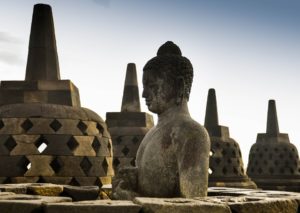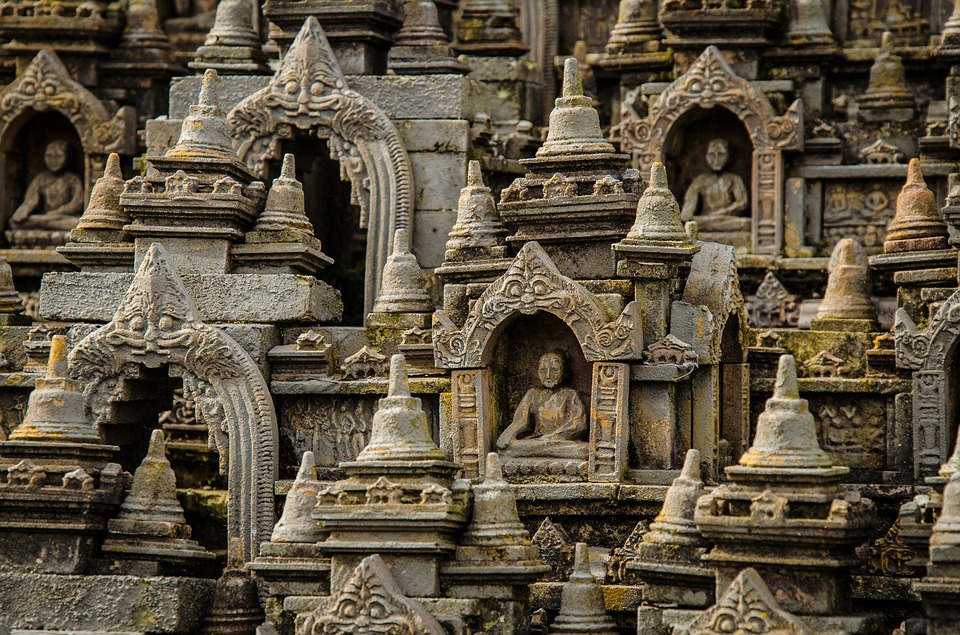Borobudur, a Buddhist stupa in the Mahayana tradition, is the largest Buddhist monument in the world. It is located on the Indonesian island of Java, 40 km (25mil) northwest of Yogyakarta, Borobudur was 750 to 850 AD.
Rediscovery of Borobudur
Borobudur was rediscovered in 1814 by Sir Thomas Stamford Raffles, who, during his visit to Semarang, he received a report on the discovery of a hill full of rocks. Hill was approved by the local population to the former location of a monument called budur. Raffles led a team led by Cornelius for the investigation on the hill.
The year 1835, that the site was cleaned. Efforts were made to the restoration and conservation of the monument from colossal. Unfortunately, in 1896, the government of Dutch colonial rule has eight containers Borobudur stones, including reliefs, statues, stairs, and doors, as gifts for the King of Siam, who on a visit to Indonesia.
A program to restore 1973 to 1984 on the biggest part of the complex to its former glory, and the location to a place of pilgrimage for Buddhists. On 21 January 1985, the temple was suffered minor damage due to a bomb attack. 1991 Borobudur was listed by UNESCO as a World Heritage Site.
Borobudur in the form of a Giant Mandala
From above, Borobudur in the form of a giant mandala, which symbolizes the path of the Bodhisattva of samsara nirvana, Overall, this huge monument more than 2 million stone blocks.
Representation for the existence of the universe, Borobudur, reflects the Buddhist cosmology, the world is divided into three levels. The three levels are Kamadhatu (world of desire), Ruphadatu (the world of forms) and Arupadhatu (World Formlessness).
The cache of the base of Borobudur was for the first level, the gallery Kamadhatu on. It is estimated that in the construction of Borobudur was a country that threatened the entire building. To prevent the collapse of the entire monument, Kamadhatu was closed and converted into a new base that holds Borobudur steady.
 This level Kamadhatu images from the world of passion and the inevitable law of karma. The first 117 panels show various actions to the same result, while the 43 other groups demonstrate the many results, only one goal. At least 160 groups have been carved relief at this level, based on the index Karmavibhangga. What remains of these programs can be found in the southeastern corner of this level.
This level Kamadhatu images from the world of passion and the inevitable law of karma. The first 117 panels show various actions to the same result, while the 43 other groups demonstrate the many results, only one goal. At least 160 groups have been carved relief at this level, based on the index Karmavibhangga. What remains of these programs can be found in the southeastern corner of this level.
The reliefs on Rupadhatu stories based on the manuscripts Lalitavistara, Jataka, Avadana and Gandavyuha. The Lalitavistara reliefs, from 120 the plates, we are talking about the life of Siddhartha Gautama Buddha. It begins with the glorious line of Buddha Tushita heaven. Born in Prince Siddhartha, the Buddha of the child was isolated from the outside world, misery. Random witness the misery of the disease, decay, and death, the young Prince Siddhartha decided to flee worldly life and begins his quest for freedom from suffering. Siddhartha research long and painful, he has finally, at the highest level of enlightenment and became the Buddha, the Enlightened One. The story ends with the sermon of the Buddha in Deer Park, near Benares.
The Jataka
The Jataka is a collection of stories about the previous life of the Buddha, canals, and virtues. After Jatak Buddha was 504 times before its birth as Prince Siddhartha, by clicking on the ways of God, kings, princes, scholars, thieves, slaves, and a player. Several times it has emerged in the forms of animals such as lions, deer, monkeys, in Switzerland, huge turtles, quail, horses, birds, and many others. But Boddhisatva (Buddha to be) differs from all other kings, of slaves, or the animals that live among them. The Boddhisatva is always high, and wiser than those around him.
As for the discharge of Avadana, the main character is not the Buddha himself All the facts in this sacred image is on other legendary characters. The stories are collected in Dvijavadana (Glorious Heavenly Acts) and Avadana Satake (The Hundred Avadana). The first 20 pictures in the background of the series of articles in the first gallery Sudhanakumaravana describe.
The series of reliefs, the wall of the second gallery is in the Sudhana wandering on his tireless search for the highest wisdom. The story is on the walls and railings of the third and fourth galleries. Most of the 460 panels, the scenes in the Mahayana Gandavyuha text, while the completion of the scenes is from the text Badracari.
In the last three high circular terraces, 72 stupas circle of the great stupa main temple crowning the top. The round shape is the eternal, without beginning and without end, a superlative, quiet, and in the world without a state of pure form. There is help in the three circular terraces.
But the greatest of all stupas central level (more or less) to the size of the statue of the Buddha’s knee, even though most of these statues are missing or damaged. There are many niches in the lower levels, the statues, but many of those missing or damaged as well.





